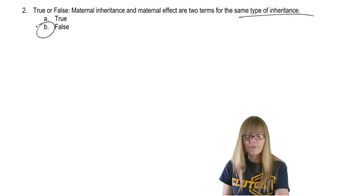The frequencies of the four alleles contributed to the child by possible father F1 in Problem 7 are 0.18, 0.23, 0.13, and 0.14. Make a statement about the possible paternity of F1 based on this analysis.
Table of contents
- 1. Introduction to Genetics51m
- 2. Mendel's Laws of Inheritance3h 37m
- 3. Extensions to Mendelian Inheritance2h 41m
- 4. Genetic Mapping and Linkage2h 28m
- 5. Genetics of Bacteria and Viruses1h 21m
- 6. Chromosomal Variation1h 48m
- 7. DNA and Chromosome Structure56m
- 8. DNA Replication1h 10m
- 9. Mitosis and Meiosis1h 34m
- 10. Transcription1h 0m
- 11. Translation58m
- 12. Gene Regulation in Prokaryotes1h 19m
- 13. Gene Regulation in Eukaryotes44m
- 14. Genetic Control of Development44m
- 15. Genomes and Genomics1h 50m
- 16. Transposable Elements47m
- 17. Mutation, Repair, and Recombination1h 6m
- 18. Molecular Genetic Tools19m
- 19. Cancer Genetics29m
- 20. Quantitative Genetics1h 26m
- 21. Population Genetics50m
- 22. Evolutionary Genetics29m
18. Molecular Genetic Tools
Methods for Analyzing DNA
Problem E.11a
Textbook Question
In an inheritance case, a man has died leaving his estate to be divided equally between 'his wife and his offspring.' His wife (M) has an adult daughter (D), and they argue that they should split the estate equally. As a young couple, however, the man and his wife had a son that they gave up for adoption. Two men have appeared, each claiming to be the son of the couple and therefore entitled to a one-third share of the estate. The accompanying illustration shows the results of DNA analysis for five genes for the mother (M), her daughter (D), and the two claimants (S1 and S2). How many nonmaternal DNA bands are shared by D and S1? By D and S2?
 Verified step by step guidance
Verified step by step guidance1
Understand that the problem involves comparing DNA bands (alleles) at multiple gene loci to determine genetic relationships. Each individual has two alleles per gene, one inherited from the mother and one from the father.
Identify the maternal alleles by comparing the mother (M) and her daughter (D). Since the daughter inherits one allele from the mother at each gene, the alleles present in both M and D represent maternal alleles.
For each gene, determine which allele in D is nonmaternal by excluding the allele shared with M. This nonmaternal allele must have come from the father.
Compare the nonmaternal alleles of D with the alleles of each claimant (S1 and S2) at the same gene loci. Count how many nonmaternal alleles are shared between D and S1, and between D and S2.
Sum the number of shared nonmaternal alleles across all five genes for each claimant. This count reflects the genetic similarity on the paternal side and helps assess which claimant is more likely to be the biological son.
 Verified video answer for a similar problem:
Verified video answer for a similar problem:This video solution was recommended by our tutors as helpful for the problem above
Video duration:
3mPlay a video:
Was this helpful?
Key Concepts
Here are the essential concepts you must grasp in order to answer the question correctly.
DNA Banding Patterns and Genetic Markers
DNA banding patterns represent specific genetic markers identified through techniques like gel electrophoresis. Each band corresponds to a DNA fragment of a particular size, inherited from parents. Comparing these bands among individuals helps determine genetic relationships by identifying shared or unique markers.
Recommended video:
Guided course

Mapping with Markers
Maternal and Nonmaternal Alleles in Inheritance
In genetic inheritance, offspring receive half their alleles from the mother and half from the father. Nonmaternal DNA bands are those not inherited from the mother, indicating paternal contribution. Identifying nonmaternal bands shared between siblings helps establish common paternity.
Recommended video:
Guided course

Types of Maternal Inheritance
Sibling Genetic Comparison for Paternity Testing
Comparing DNA bands between siblings can reveal shared paternal alleles, confirming biological relationships. Full siblings share both maternal and paternal alleles, while half-siblings share only one parent's alleles. Counting shared nonmaternal bands helps assess claims of common paternity.
Recommended video:
Guided course

History of Genetics

 7:40m
7:40mWatch next
Master Methods for Analyzing DNA and RNA with a bite sized video explanation from Kylia
Start learningRelated Videos
Related Practice
Textbook Question
350
views
